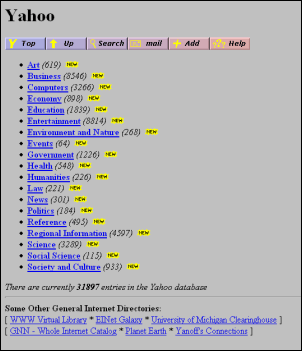Thursday, March 3, 2005
New Public Gallery
Zeldman points to the just-opened New York Public Library Digital Gallery with free access to over 275,000 digitized images. The site’s server is under some stress today and not all images seem to load. According to the NYPL, only private study of the images is allowed and any publication of the material is prohibited (I guess that doesn’t include images older than 75 years).
Google Behind the Scenes Lecture Video
RC in the forum points to Google: A Behind-the-Scenes Look by Googler John Dean at the University of Washington.
Pagesauce
Pagesauce.com invites web developers to convert big sites – like NYTimes.com or Yahoo.com – into a more modern XHTML + CSS approach.
Pipe Dream Video
In the fascinating 3d animated Pipe Dream [MPEG], all instruments are played by steel balls shot out of PVC tubing. Archive.org says, “Proprietary animation software analyzes the music, and automatically drives the movement of the instruments for highly accurate and efficient animation. Essentially no traditional keyframing is used.”
Retro Yahoo

As part of Yahoo’s 10 year anniversary promotion, the company show-cases how their homepage looked like in 1995. [Via Kottke, who found an even earlier version from 1994.]
Kottke Pro AutoLinks
Jason Kottke says you should naturally just use Google’s AutoLink feature if you trust Google, but also that most arguments which have been voiced against the new toolbar feature – it’s like Smart Tags, it changes the HTML – are not valid.
Google Eyetracking
This is the eye movement in Google from a usability study with eye-tracking software. No total text ad blindness, as you can see. The accompanying press release says the study “verifies the importance of page position and rank in both Organic and PPC search results for visibility and click through in Google.” [Via El Telendro.]
Types of Search Engine Spam
According to Shari Thurow, who’s quoted by Glenn J. Kalinoski, there are 19 types of search engine spam:
- Keywords unrelated to site
- Keyword stacking
- Keyword stuffing
- Hidden text
- Tiny text
- Hidden links
- Link farms
- Page swapping (bait and switch)
- Redirects
- Mirror/ duplicate content
- Doorway/ gateway pages
- Cloaking
- Gibberish
- Domain spam
- Mini/ micro-sites
- Typo spam and cybersquatting
- Affiliate spam
- Blog/ forum spam
- CSS spam
Winer on Google OS
“Okay, we don’t know for a fact that Google is working on an operating system, but the tea leaves are pretty damned clear. Why else would they have hired Microsoft’s operating system architect, Mark Lucovsky? Surely not to write a spreadsheet or word processor.”
[Thanks RC in the forum.]
The Biggest Flop in Video Game History

Gadgetopia points to the Wikipedia article on E.T., arguably the biggest flop in video game history. It was programmed in 8 weeks (by a skilled programmer, nevertheless), and the licensing costs alone were $20 million. Wikipedia writes:
“Atari anticipated enormous sales based on the popularity of the movie, but the game ended up selling surprisingly poorly. Opinions on the actual quality of the game range from “unbelievably bad” to “moderately enjoyable.” (...)
Atari produced more cartridges than there were 2600 game consoles in existence at the time. Most of them wound up in landfills and as tax writeoffs. This game was one of many bad decisions that led to the bankruptcy of Atari (which posted a $536 million loss in 1983, and was divided and sold in 1984). It is also seen as one of two major video game releases (along with the Atari 2600 version of Pac-Man) that sparked the video game crash of 1983.”
Random Person Generator
The fun Generator Blog points to the Person Generator (which does nothing but generate random persons, male or female, with their own face and characteristics).
>> More posts
Advertisement
This site unofficially covers Google™ and more with some rights reserved. Join our forum!

